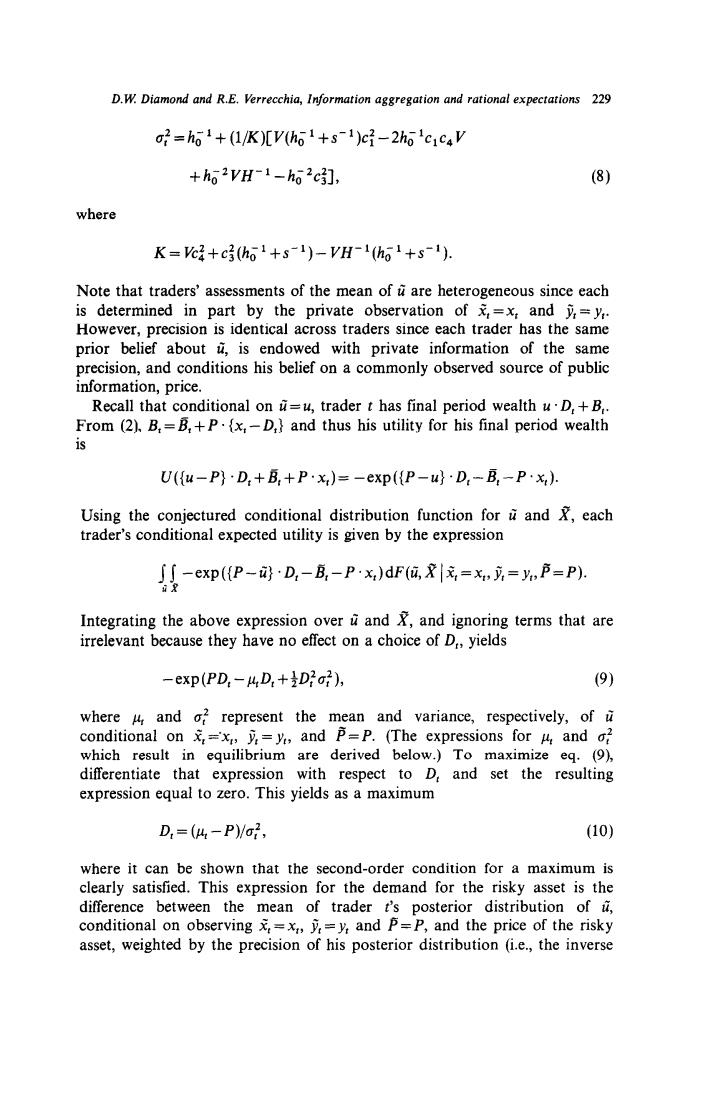正在加载图片...

D.W.Diamond and R.E.Verrecchia,Information aggregation and rational expectations 229 o=h61+(1K)[V(h1+s-1)c-2ho'c1c4V +ho2VH-1-ho 2c3], (8) where K=e经+c3(ho1+s-1)-VH-1(ho1+s-1) Note that traders'assessments of the mean of a are heterogeneous since each is determined in part by the private observation of=x and =y. However,precision is identical across traders since each trader has the same prior belief about is endowed with private information of the same precision,and conditions his belief on a commonly observed source of public information,price. Recall that conditional on i=u,trader t has final period wealth uD.+B.. From (2).B.=B,+P.{x,-D,}and thus his utility for his final period wealth U({u-P}·D,+B,+P·x)=-exp({P-u}·D.-B,-P·x) Using the conjectured conditional distribution function for and X,each trader's conditional expected utility is given by the expression -exp(P-~D-B-Px)dFaX=x,成=庐=P) Integrating the above expression over and X,and ignoring terms that are irrelevant because they have no effect on a choice of D.,yields -exp(PD-uD+D2:), (9) where and o?represent the mean and variance,respectively,of conditional on=x =y,and P=P.(The expressions for u and which result in equilibrium are derived below.)To maximize eq.(9), differentiate that expression with respect to D.and set the resulting expression equal to zero.This yields as a maximum D,=(4-P)/a, (10) where it can be shown that the second-order condition for a maximum is clearly satisfied.This expression for the demand for the risky asset is the difference between the mean of trader t's posterior distribution of conditional on observing=x=y,and p=P,and the price of the risky asset,weighted by the precision of his posterior distribution (i.e.,the inverseD.W Diamond and R.E. Verrecchia, Information aggregation and rational expectations 229 a:=h,‘+(l/K)[l/(h,‘+s-‘)c:-2h,‘c,c,I/ where +h,WP--h;%~], (8) K=Vc:+c:(h,‘+s-‘)-~H-‘(h,‘+s-‘). Note that traders’ assessments of the mean of fi are heterogeneous since each is determined in part by the private observation of 3, =x, and ~,=JJ,. However, precision is identical across traders since each trader has the same prior belief about ti, is endowed with private information of the same precision, and conditions his belief on a commonly observed source of public information, price. Recall that conditional on ii=u, trader t has final period wealth u. D, +B,. From (2), B, = & + P. {x, - Dt> and thus his utility for his final period wealth is U({u-P} .D,+B,+P.x,)= -exp({P-u} .D,-B,--P.x,). Using the conjectured conditional distribution function for ti and 8, each trader’s conditional expected utility is given by the expression ~r-exp({P-~i.D,-8,-P.x,)d~(~,R(~,=x,,~,=y,,P=P). Integrating the above expression over t? and 8, and ignoring terms that are irrelevant because they have no effect on a -exp(PD,-pLrD,+fD:c$), where pr and 0: represent the mean choice of D,, yields (9) and variance, respectively, of zi conditional on z?~ =‘x$, ~7~ = y,, and P=P. (The expressions for u and 0: which result in equilibrium are derived below.) To maximize eq. (9), differentiate that expression with respect to D, and set the resulting expression equal to zero. This yields as a maximum D,=(P,-WJ,~, (10) where it can be shown that the second-order condition for a maximum is clearly satisfied. This expression for the demand for the risky asset is the difference between the mean of trader t’s posterior distribution of iZ, conditional on observing ZC = xt, jjC = y, and P” =P, and the price of the risky asset, weighted by the precision of his posterior distribution (i.e., the inverse